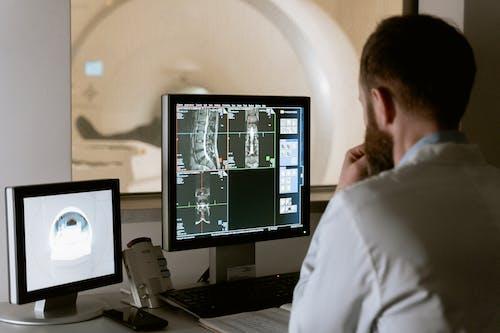New opportunities for enhancing health and well-being have emerged. Mobile applications, wearable devices, telemedicine, and artificial intelligence are examples of digital health technologies that provide easy, accessible, and customized means of providing health care and associated services.
However, digital healthcare solutions are more than tools or goods; they are part of a larger shift in how healthcare is structured, provided, and experienced.
This article investigates how digital health solutions might bring about a paradigm change in patient-centric care, defined as treatment that respects and responds to individual patient choices, needs, and values.

Rise of digital health solutions
Digital health technologies have transformed the healthcare environment, empowering people and changing how healthcare is provided. Digital health solutions have opened new avenues for improved access to healthcare services, enhanced patient engagement, and personalized care by integrating innovative technologies such as telemedicine, mobile health applications, electronic health records, and artificial intelligence.
Telemedicine and virtual care have enabled patients to consult with healthcare experts at a distance, lowering geographical obstacles and enhancing convenience. Individuals can actively engage in healthcare by using mobile health apps and wearable devices to monitor their health parameters and obtain tailored health information.
Electronic health records have simplified patient data administration, allowing healthcare practitioners to coordinate better and communicate. Artificial intelligence and machine learning have enabled data-driven insights, predictive analytics, and individualized treatment regimens, improving patient outcomes.
Key Digital health solutions driving the paradigm shift
Diverse cutting-edge technologies are transforming the healthcare system, fueling the growth of digital health solutions.
Let’s look at a few of the most important digital health solutions that are causing this shift:
-
Telemedicine and virtual care
Remote medical diagnosis and treatment: The advent of telemedicine and other forms of virtual care has revolutionized access to medical advice and treatment. Patients no longer need to physically see their doctors to obtain timely medical advice thanks to video conferencing and remote monitoring.
People living in isolated places, people with mobility issues, and those looking for quick healthcare delivery would all benefit greatly from this digital solution.
-
Mobile health applications (apps) and wearables
Health-related apps for mobile devices and wearable technology: People are now better equipped to take charge of their health thanks to mobile health apps and wearable technologies. Numerous health applications allow users to monitor their fitness progress, check their vitals, deal with chronic illnesses, and get individualized advice on improving their health.
Smartwatches and fitness trackers are examples of wearable gadgets that collect data on an individual’s activity, sleep, and heart rate in real-time, empowering the user to take charge of their health.
-
Electronic health records (EHRs) and interoperability
Interoperability with electronic health records (EHRs): The management and sharing of patient data across healthcare providers have been entirely transformed by electronic health records and interoperability.
Electronic health records (EHRs) automate patient data collection, storage, and retrieval, eliminating the need for paper records and allowing for more fluid information sharing.
-
Artificial intelligence (AI) and machine learning in healthcare
Healthcare applications of artificial intelligence (AI) and machine learning There is great promise for using AI and ML to improve healthcare delivery. To aid in diagnosis, treatment planning, and patient monitoring, AI systems can sift through mountains of medical data in search of trends.
Disease progression, high-risk people, and individualized treatment plans can all be predicted using machine learning algorithms. Furthermore, chatbots and virtual assistants powered by AI can give round-the-clock help to patients by fielding questions and delivering basic medical information.
Overcoming challenges and adoption barriers
While the rise of digital health solutions presents enormous opportunities, several obstacles and adoption hurdles must be overcome.
Let’s examine some crucial areas:
-
Data security and privacy concerns
Data security and patient privacy are paramount in the digitization of healthcare data.
Protecting sensitive medical data from unauthorized access, breaches, and cyber threats requires stringent security measures, encryption protocols, and HIPAA compliance.
-
Infrastructure and resource requirements
Implementing digital health solutions requires a solid technological infrastructure and sufficient resources.
Access to a high-speed internet connection, dependable connectivity, and advanced hardware and software systems are essential for telemedicine, data exchange, and remote monitoring to function without interruption.
-
Regulatory and legal considerations
Digital health solutions operate in a complex regulatory environment. Compliance with regulations and legal frameworks about telemedicine, data privacy, interoperability, and medical device approvals is essential.
Policymakers must establish explicit guidelines and standards to guarantee patient safety, ethical use of data, and equal access to digital health services.
Final words
Digital health solutions have shifted healthcare focus from providers to patients, making medical treatment more individualized and convenient.
Patients can now have remote access to healthcare, take an active role in their well-being, and reap the benefits of data-driven insights thanks to telemedicine, mobile health apps, electronic health records, and artificial intelligence.
However, obstacles, including data security, infrastructural needs, and regulatory concerns, must be surmounted to exploit these solutions’ promise fully.
Interesting Related Article: “10 Healthcare Technology Trends to Improve Your Well-Being“
